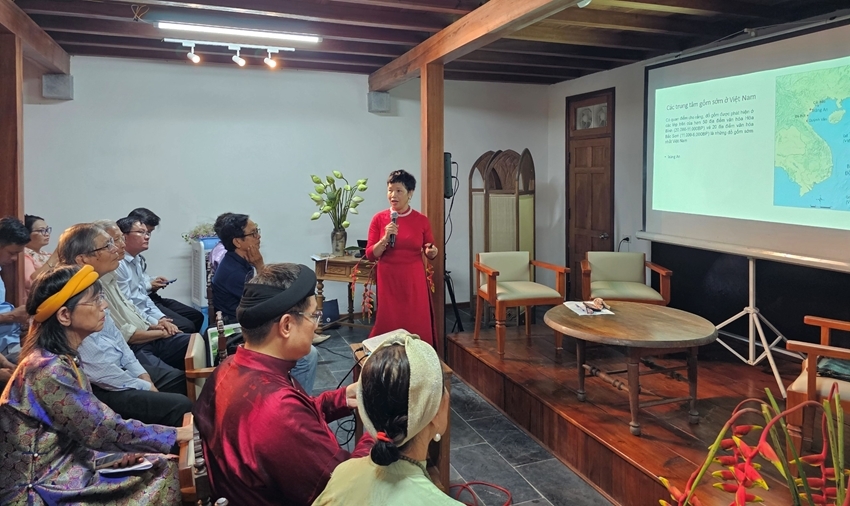 |
| Prof. Dr. Lam Thi My Dung sharing at the workshop |
The workshop was organized by the Huong River Ancient Ceramic Museum on the occasion of International Museum Day and 2 years since the museum officially came into operation. A large number of experts and researchers from many places across the country attended and discussed at the workshop.
Reflecting the development of creative thinking
According to Prof. Lam Thi My Dung, the invention of ceramics represents an important step in human cultural and technological development, marking the beginning of porcelain making as an essential part of everyday life and artistic expression. It can be said that the invention of pottery is the result of independent inventions in many regions of the world, based on the experience of using fire and exploiting resources from previous periods.
In Vietnam, according to many researchers, ceramics also appeared quite early, associated with the economy of farming, settlement, and grinding tools. Previously, ceramics were said to have started to be used from the Hoa Binh and Bac Son cultures about 10,000 years ago. However, later research shows that the majority of pottery shards in caves belonging to these cultures may be from a later period, when caves were used to bury the dead or take shelter.
Current archaeological discoveries in Vietnam confirm that there are four earliest pottery areas located on the coast from North to South, including Cai Beo, Trang An, Da But, and Quynh Van. The ceramics produced and used in these four areas are all associated with the settled lifestyle in caves or outdoors, and the economy of natural exploitation, especially marine resources. Each region has its own characteristics of pottery according to material, type, and decoration.
With this advent, Prof. Lam Thi My Dung said that ceramics have brought many benefits to human life, including the ability to contain and preserve food, water, as well as other materials. This improves hygiene and food safety, and opens up many opportunities for economic activities and exchange. The invention of ceramics also reflects the development of creative thinking and human technical abilities. Pottery not only has a practical function but also has high artistic value, with many diverse patterns and designs, expressing the richness of culture and beliefs of prehistoric communities.
“Over time, ceramic making techniques have been increasingly improved and developed, from simple hand molding to the use of specialized turntables and kilns. The development of ceramics made an important contribution to shaping early civilizations, playing an essential role in the progress of humanity," said Prof. Lam Thi My Dung.
Ancient pottery from the Huong River is a valuable material resource
When talking about ceramics, we cannot help but mentioning the Huong River flowing through Hue Citadel. A large volume of ceramics recovered from this river reflects specifically and accurately the daily lives of residents through historical periods, since people knew how to make pottery and grow rice thousands of years ago until today.
 |
| Displaying ceramics on the sidelines of the workshop |
Dr. Phan Thanh Hai, Director of the Department of Culture and Sports, said that although it is called Huong River ceramics, it actually includes crockery, porcelain, ceramics, and semi-porcelain with extremely rich types: vases, jars, kettles, bowls, cups, plates, bases, lids, lime jars, pots, nets, etc.
The appearance of ceramics in the Huong River reflects the exchange process between regions of Vietnam, between Hue and the central provinces, and the northern and southern provinces; reflects the international exchange process of Hue area residents with many countries: China, Japan, Southeast Asian countries, and even Western countries.
“However, Huong River ceramics appeared quite randomly and have only been noticed in the past century or so through fishing activities and salvaging antiques, sand, and gravel from the riverbed by sampan residents and people who make a living from river work. In the early 20th century, ceramics and antiques from the Huong River were of interest to some French researchers, but perhaps it was not until the 70s and 80s that they were systematically collected to form a number of valuable collections," Mr. Hai shared.
Dr. Nguyen Anh Thu (Hanoi University of Culture) affirmed that the ancient ceramics salvaged from the Huong River clearly reflect the development process of Hue through 3 main stages: pre-Sa Huynh - Sa Huynh 2nd century BC to the first centuries AD pottery group; Champa pottery group from the 2nd to the 14th century; The group of Vietnamese crockery, porcelain, and glazed ceramics spans historical periods from the Han Dynasty to the Nguyen Dynasty and later. There are also many ceramics that are products of cultural exchange, belonging to the Han, Tang, Song, Yuan, Ming, and Qing dynasties (China), Thai glazed ceramics, and Hizen ceramics (Japan), and later European high-class ceramics.
According to research by Dr. Anh Thu, based on function, ceramics salvaged from the Huong River can be divided into 3 main groups: cooking utensils, household utensils, and containers. “Ancient ceramics from the Huong River are a valuable source of material that helps researchers identify an important part of Hue's historical and cultural values in the context of the historical and cultural flow of Central Vietnam”, Dr. Anh Thu concluded.
Story and photos: N. MINH